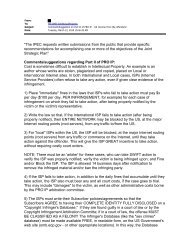We Energies Coal Combustion Products ... - The White House
We Energies Coal Combustion Products ... - The White House
We Energies Coal Combustion Products ... - The White House
Create successful ePaper yourself
Turn your PDF publications into a flip-book with our unique Google optimized e-Paper software.
<strong>The</strong> following tests were performed:<br />
• Particle size analysis (ASTM D-422)<br />
• Moisture-density relationship test - to establish maximum dry density<br />
(ASTM D-698-78, Method A).<br />
• California Bearing Ratio (CBR) test - to develop a basis for comparison of<br />
bottom ash material with conventional base course aggregates (ASTM D<br />
1883).<br />
• Laboratory permeability test (ASTM D-2434)<br />
• Direct shear test - to determine the angle of internal friction (ASTM D<br />
3080)<br />
<strong>The</strong> scope of this study included establishing an equivalent thickness of<br />
bottom ash compared to conventional aggregates in road construction. To<br />
address frost susceptibility in a meaningful manner, a sample of bottom ash<br />
was compacted into a 6” mold at its optimum moisture content. <strong>The</strong> mold with<br />
its perforated base was placed in a container of water for three (3) days to<br />
allow the sample to absorb water. <strong>The</strong> sample was then frozen and<br />
subsequently thawed. Volume change measurements were made after both<br />
freezing and thawing.<br />
<strong>The</strong> gradation of bottom ash tested was comparable to a silty fine to coarse<br />
sand with little gravel. However, bottom ash was considerably finer grained<br />
than the conventional gradation for fine aggregate.<br />
<strong>The</strong> PPPP bottom ash exhibited a maximum dry density of 88.5 pounds per<br />
cubic foot and optimum water content of 28%. Conventional aggregates have<br />
maximum densities in the range of 105 to 120 lb/cu ft. at optimum moisture<br />
contents typically in the range of 8% to 16%.<br />
<strong>The</strong> CBR test results showed PPPP bottom ash had a CBR value on the order<br />
of 30% of that of conventional aggregate. In general, more coarsely graded<br />
and more angular materials tend to exhibit greater stiffness and tend to<br />
distribute load more evenly. <strong>The</strong> results showed that when used in a<br />
comparable thickness, bottom ash exhibits less favorable load distribution<br />
characteristics and would be more flexible, i.e., greater surface deformation<br />
under a load, than for conventional aggregates.<br />
However, based on accepted pavement design principles, it was estimated that<br />
bottom ash used at approximately 1.5 times the thickness of conventional<br />
aggregates achieves a comparable stress level in the underlying clay subgrade.<br />
For equivalent deformation, it was estimated that the thickness of bottom ash<br />
should be two times the thickness of conventional aggregates to maintain<br />
similar deflection at the surface of the base course layer (42). Figure 6-1<br />
shows the stress penetration CBR curve for PPPP bottom ash.<br />
<strong>We</strong> <strong>Energies</strong> 160<br />
<strong>Coal</strong> <strong>Combustion</strong> <strong>Products</strong><br />
Utilization Handbook



